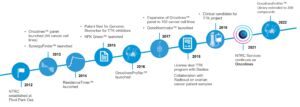Oncolines to present detailed profiling of recently approved kinase inhibitors at the ESMO TAT
Currently approved small molecule kinase inhibitors act only through a limited number of kinase targets. Well-known targets are EGFR, BCR-ABL and ALK. Recently, several inhibitors of new kinase targets have been approved. These include inhibitors of the kinases FGFR, TRK and RET.
How do inhibitors of these new targets differ from each other? What are their selectivity profiles?
At the virtual Targeted Anticancer Therapy (TAT) conference on 7-8 March, Oncolines’ Jeffrey Kooijman will present a detailed analysis of the selectivity and potency profiles of small molecule inhibitors of FGFR, RET and ALK. All recently approved kinase inhibitors were profiled on a panel of 255 biochemical kinase assays at Carna and in proliferation assays of 134 human cancer cell lines at Oncolines.

Figure. A] Kinome trees of recently approved RET inhibitors. Inhibitory activity at 1 µM is indicated. B] Dose-response curves of RET inhibitors tested in proliferation assays on the NTRK3 fusion-positive cell line AP-1060.
To illustrate the power of the approach, the results of the biochemical kinase profiling of the RET inhibitors pralsetinib and selpercatinib is presented in the figure above. This shows subtle differences in selectivity, where pralsetinib inhibits TRKA/B/C, but selpercatinib does not [A]. This difference translates well to a cellular context, in which the proliferation of a TRK-driven cell line is more potently inhibited by pralsetinib compared to selpercatinib [B].
The TAT conference is organized by the European Society of Medical Oncology (ESMO) The poster will be available on request at info@oncolines.com following the conference.
Reference
Kooijman et al. (2022) Comparative biochemical and cellular profiling of kinase inhibitors approved for clinical use from 2018 to 2020. ESMO TAT abstract #265
About Oncolines
Oncolines B.V. is a precision medicine services company in oncology and cancer immunotherapy. We help to bring improved and novel therapies to the right patient population faster. We offer a set of complimentary services to enable our clients to characterize their compounds, and to determine activities, selectivities and mechanism of action. We present results in a unique and interactive reporting format that facilitates easier and faster interpretation of results.






